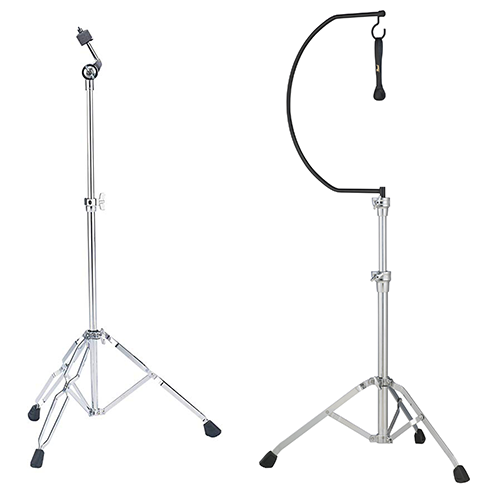by
Rhythm Scene Staff
| Jan 24, 2020
As discussed in my previous article, in early music education, “weaker” percussionists often get placed on cymbal parts. This breeds the idea that cymbals are easy to play and may perpetuate the notion that these parts are less important. To the contrary, cymbals are a beautiful color instrument in percussion, a highly exposed instrument in the section, and serve to enhance any ensemble if played properly. To truly get the best sound possible, careful thought must be given to a variety of elements. In this article we will take a look at the suspended cymbal.
Our first consideration needs to be equipment. There are as many opinions on cymbal selection as there are styles (German, Viennese, French, etc.) and sizes. While the art of cymbal selection is beyond the scope of this article, it does merit a brief discussion. Important cymbals to avoid using, unless otherwise asked for by the composer, are hi-hat cymbals, ride cymbals, and splash cymbals. Hi-hat cymbals are on the small side and, along with ride cymbals, are too thick to get a characteristic suspended cymbal sound. Splash cymbals are too small and too thin. Cymbals are quite expensive, and sometimes schools do not own specific cymbals marketed as “suspended cymbals.” Drum set crash cymbals can be suitable alternatives. Generally, these should be on the larger side (16–20 inches) for the best sound.
Cymbals should be mounted on either a straight cymbal stand or gooseneck stand. The latter is used to hang a cymbal that has a strap (like a handheld crash cymbal). It is also the preferred way to suspend a cymbal, as it is least restrictive; the cymbal can freely vibrate when not tightened to a stand. If mounted on a cymbal stand, make sure there is a plastic sleeve and felts above and below the cymbal to avoid metal-on-metal contact and buzzing. Do not tighten the wingnut too much, as this can choke the cymbal and cut off its natural resonance.

Many types of implements can be used to strike the cymbal, the most common of which is a soft mallet. Sometimes composers may ask for a timpani mallet when they are thinking of a softer mallet; however, a timpani mallet is generally too light; when rolling or crashing, too much of the core will be heard. Ideally, a heavy yarn mallet should be used, as this will disguise the individual strokes when rolling and avoid an abrasive attack when crashing. If a composer asks specifically for a drumstick to achieve a more percussive attack, generally, a thicker drumstick is best for this.
There are two main types of sounds on the suspended cymbal: crash and roll. Especially for a crash, “warm up” the cymbal by lightly tapping on the cymbal either with the mallet or your finger to activate its natural vibration. Strike near the edge of the cymbal, not too close to the center. Let the weight of the heavy yarn mallet do most of the work. A slow, even, and relaxed stroke will bring out the best sound. If a drumstick is called for, turn the stick around or use the shoulder of the stick. The stick tip should only be used if instructed since it is more characteristic of a drum set ride cymbal sound. Strike the cymbal on the top, but near the edge. Unlike in drum set playing in which the stick comes at an angle, the concert crash should be struck with a stick that is more parallel with the cymbal.
For suspended cymbal rolls, mallets should be spread out, but across from each other, to activate the most resonant sound. Strokes should be relaxed and even to get the best sounding sustain. Softer dynamics require a slower roll speed, while louder dynamics require a faster roll speed. This is especially important for crescendos as the roll speed should gradually increase. In general, suspended cymbal roll crescendos sound best when the crescendo is delayed and grows more quickly at the end. It is important to use your ears, as you do not want the cymbal to wash out the ensemble by rolling too loudly too early.
A final consideration is dampening. Pay attention to the marked duration of the note, and if there is a let ring/vibrate marking (a small tie to nothing or l.v.). To dampen, simply clasp the cymbal with one or both hands. When the cymbal must be dampened quickly, keep the shaft of the stick from hitting the cymbal and making extraneous noise. Sometimes composers and/or arrangers do not accurately notate note duration or how long the cymbal should ring. Always use your ears to listen to the ensemble to see what makes most sense. Context will provide all the clues you need to make an educated decision.
 Dr. Alexandros Fragiskatos is Assistant Professor of Instrumental Music at Missouri Valley College. A proponent of contemporary music, he has commissioned, premiered, and performed new works across the U.S. and Europe. Alex also plays percussion and drum set for musical theatre, as well as steel pan, having directed the Arizona State University Pan Devils Steel Band while earning his Doctor of Musical Arts degree in percussion. For more information about Alex, visit fragiskatospercussion.com.
Dr. Alexandros Fragiskatos is Assistant Professor of Instrumental Music at Missouri Valley College. A proponent of contemporary music, he has commissioned, premiered, and performed new works across the U.S. and Europe. Alex also plays percussion and drum set for musical theatre, as well as steel pan, having directed the Arizona State University Pan Devils Steel Band while earning his Doctor of Musical Arts degree in percussion. For more information about Alex, visit fragiskatospercussion.com.